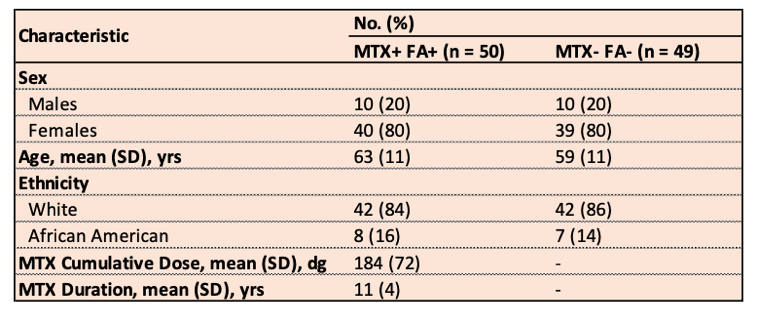Session Information
Date: Sunday, November 13, 2022
Title: RA – Treatment Poster II
Session Type: Poster Session B
Session Time: 9:00AM-10:30AM
Background/Purpose: Rheumatoid arthritis (RA) is an inflammatory arthritis in which the immune system targets synovial joints. Methotrexate, a dihydrofolate reductase and aminoimidazole-4-carboxamide ribonucleotide transformylase inhibitor, serves as the first-line treatment for RA due to its efficacy and accessibility. However, the antifolate properties of methotrexate, which can lead to side effects such as cytopenias and gastrointestinal symptoms, limit its usefulness in some patients with RA. Furthermore, patients treated with methotrexate require concurrent folic acid supplementation and are uniquely at risk for vitamin B12 deficiency and hyperhomocysteinemia due to biochemical processes involving folate, methotrexate, and vitamin B12.
Methods: In this cross-sectional study we compared plasma vitamin B12, methylmalonic acid, and homocysteine levels between 50 RA patients treated with methotrexate and folic acid and 49 RA patients using other DMARDs. All patients met the 2010 American College of Rheumatology RA classification criteria and were participants of an established RA inception cohort. The patients selected for this study were matched by age, sex, and ethnicity. A Chi-square goodness of fit test was utilized to compare the proportion of patients in both groups with low, normal, and/or high plasma vitamin B12, methylmalonic acid, and homocysteine levels per the laboratory’s specification of the normal range for these measurements.
Results: There were 10 men and 42 White individuals in each group. Those in the methotrexate and folic acid group had received a mean (SD) cumulative methotrexate dose of 184 (72) decigrams over 11 (4) years and had a mean (SD) age of 63 (11) years compared to 59 (11) years for patients on other therapies (Table 1). Our findings revealed elevated plasma homocysteine levels in 37 (74%) RA patients on methotrexate and folic acid compared to only 27 (55%) patients on other therapies (Chi-square p-value 0.049) (Table 2). We did not find differences in the proportion of patients with low, normal, or high plasma vitamin B12 and methylmalonic acid levels between the two groups.
Conclusion: Our data show high plasma homocysteine levels among RA patients treated with methotrexate and folic acid. While the proportion of patients with low plasma vitamin B12 levels did not significantly differ between the two groups, elevated plasma homocysteine is a more sensitive marker of vitamin B12 deficiency. Additional studies are needed to evaluate for clinical features of vitamin B12 deficiency and hyperhomocysteinemia and determine if monitoring of vitamin B12 status and supplementation are warranted among RA patients treated with methotrexate and folic acid.
To cite this abstract in AMA style:
Patel A, Morgan S, Green R, Danila M, Merriman T, Wanzeck K, Ahmed H, Gaffo A. Vitamin B12 Status and Hyperhomocysteinemia in Patients with Rheumatoid Arthritis Treated with Methotrexate and Folic Acid [abstract]. Arthritis Rheumatol. 2022; 74 (suppl 9). https://acrabstracts.org/abstract/vitamin-b12-status-and-hyperhomocysteinemia-in-patients-with-rheumatoid-arthritis-treated-with-methotrexate-and-folic-acid/. Accessed .« Back to ACR Convergence 2022
ACR Meeting Abstracts - https://acrabstracts.org/abstract/vitamin-b12-status-and-hyperhomocysteinemia-in-patients-with-rheumatoid-arthritis-treated-with-methotrexate-and-folic-acid/


